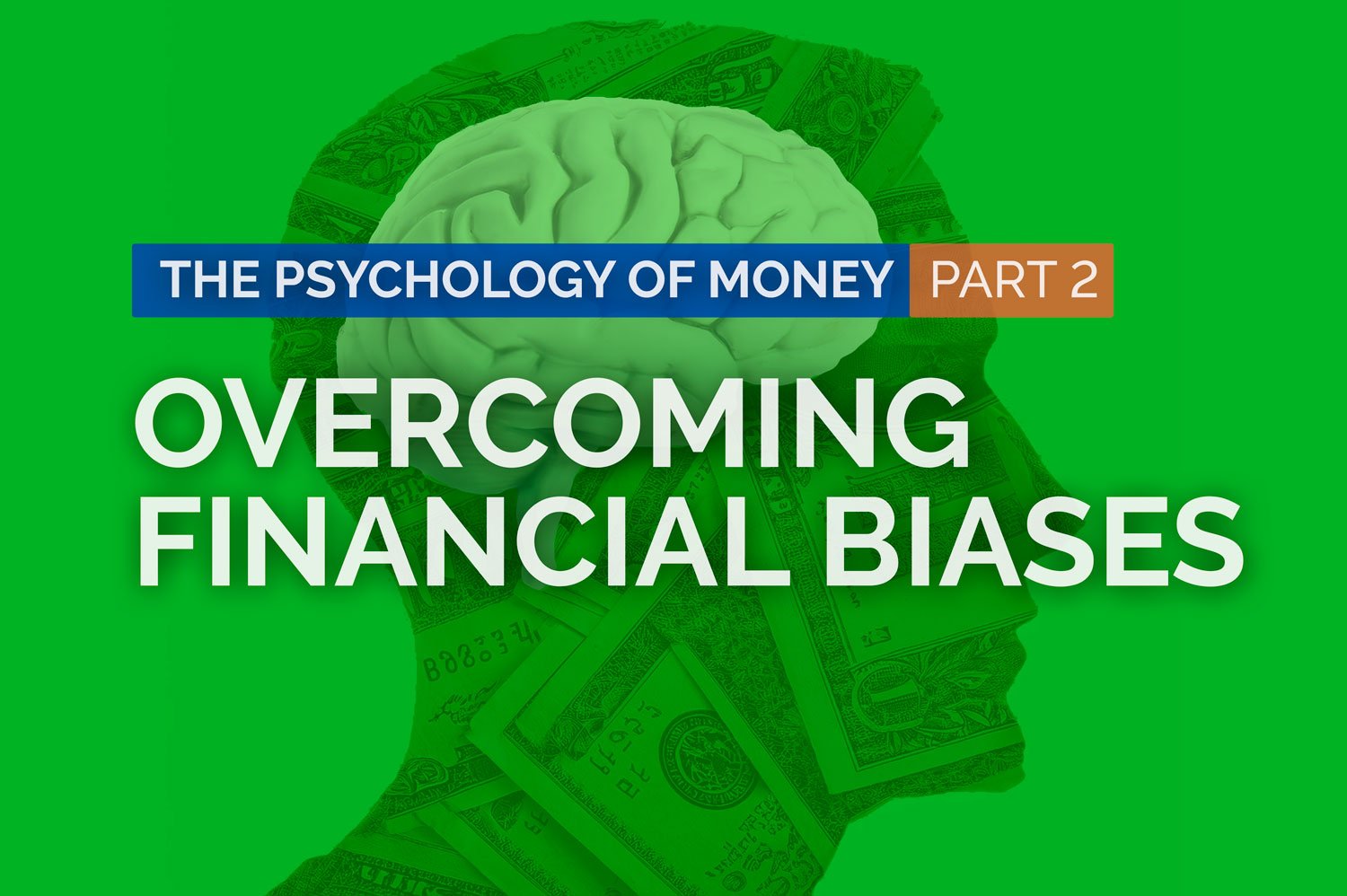Welcome to Part 2 of our series, “The Psychology of Money.” If you’ve made it this far, you’ve already started to explore the emotional side of financial decision-making. In the first article, we talked about the powerful role emotions play when we manage our money. Fear, greed, envy, and regret can cloud our judgment, often leading to decisions that aren’t in our best interest. We also discussed how recognizing these emotions is the first step toward gaining control over your financial future.
In this article, we’ll dive deeper into another big influence on our financial choices: biases. Just like emotions, biases can seriously affect the way we handle money. They’re those little mental shortcuts that help us make quick decisions but can also lead us astray. By learning to identify and overcome these biases, you’ll be better equipped to make smarter, more rational financial choices. We’ll cover common biases like loss aversion, anchoring, and confirmation bias, and we’ll also explore practical strategies to counteract them. By the end, you’ll have a solid foundation to start recognizing these traps and making better decisions for your financial future.
Table of Contents
Identifying Financial Biases
We all like to think we make logical, well-reasoned decisions, especially when it comes to money. But in reality, our brains often take shortcuts, leading us to fall into the trap of cognitive and behavioral biases. These biases can skew our perception of value, risk, and reward, leading to poor financial outcomes. The first step to overcoming biases is recognizing them. Let’s walk through some of the most common financial biases and see how they might be affecting you.
Loss Aversion
Loss aversion is one of the most common and powerful financial biases. People tend to fear losses more than they value equivalent gains. Imagine you own a stock that’s losing value. Despite clear signs from market analysis and company performance that you should sell, you hold on, hoping it will recover.

This is classic loss aversion. You’re more sensitive to the thought of losing money than to the potential benefits of moving on. This bias can lead to holding onto poor investments far too long, missing out on better opportunities.
Anchoring Bias
Anchoring bias happens when we rely too heavily on the first piece of information we receive. For example, let’s say you come across a new investment opportunity with a target return of 8%. You recently saw another investment promising a 10% return, so you feel that 8% isn’t good enough, even though it’s a reasonable and achievable rate of return.
In this case, you’ve anchored your expectations to that 10% figure, which makes the 8% offer seem less appealing. This can lead you to miss out on solid investment opportunities just because they don’t meet an arbitrary expectation.
Herding Behavior
Humans are social creatures, and we tend to follow the crowd. This instinct is the basis of herding behavior, where investors buy or sell stocks based on what others are doing rather than on their own research or financial goals.
For instance, when a stock becomes trendy, like during a market bubble, people tend to buy in just because everyone else is doing it. However, this can drive asset prices to unsustainable levels, eventually leading to losses when the bubble bursts. By following the crowd, you might end up with an overvalued asset, resulting in financial losses when reality sets in.
Overconfidence Bias
Overconfidence can make us believe we’re better at managing our finances than we really are. In the world of investing, overconfidence bias can lead to risky decisions. For example, an investor who believes they have superior knowledge may make impulsive trades or concentrate their investments in one area, underestimating the risks involved.

This overconfidence often leads to mistakes that could have been avoided with a more cautious, well-researched approach. Remember, no one can predict the market perfectly, and having too much confidence in your abilities can lead to significant financial losses.
Confirmation Bias
Have you ever sought out information that confirms what you already believe while ignoring evidence that contradicts it? If so, you’ve experienced confirmation bias. This is especially common in investing, where an investor might focus only on news or opinions that support their current strategy.
For example, if you’re convinced a particular stock will perform well, you may seek out articles and analysis that back up that belief, while dismissing any negative reports. This can prevent you from seeing the full picture and making a well-informed decision, ultimately leading to poor investment outcomes.
Endowment Effect
The endowment effect is the tendency to value something more highly just because we own it. This can lead to irrational decision-making when it comes to selling assets. For instance, if you hold an underperforming stock, you might refuse to sell it, even if it could be sold for a profit, simply because you feel more attached to it.
The endowment effect often leads people to hold onto assets they no longer need or want, which can prevent them from reallocating their investments to more profitable options.
Status Quo Bias
Finally, there’s status quo bias—the preference to keep things the way they are, even if making a change could be more beneficial. For example, if you’ve been following the same investment strategy for years, you might be reluctant to change it, even if there are better options available.
Status quo bias can prevent you from adapting to new information or shifting market conditions, which may result in missed opportunities for growth.
Strategies for Overcoming Biases
Now that we’ve explored the most common financial biases, the next step is learning how to overcome them. The good news? There are plenty of strategies to help you make more rational, objective decisions when it comes to your finances.
Here are a few simple but effective approaches to help you avoid common financial traps:
Diversification
One of the most effective ways to reduce risk and combat biases like overconfidence and herding behavior is through diversification. Instead of putting all your eggs in one basket, diversify your investments across different asset classes, sectors, and geographies. This helps to spread risk and improve the likelihood of stable returns, even if one area underperforms.
When your portfolio is well-diversified, you’re less likely to fall into the trap of overvaluing a single investment or following the crowd into risky investments.
Goal Setting
It’s easy to let emotions and biases take over when you don’t have clear financial goals in mind. By setting specific, achievable financial objectives, you can keep your decision-making grounded in logic. When you know exactly what you’re working toward, whether it’s retirement, buying a house, or building an emergency fund, it’s easier to stay focused and avoid emotional or impulsive decisions.
Make sure your goals are SMART (Specific, Measurable, Achievable, Relevant, Time-bound). For example, instead of saying, “I want to save more money,” set a goal like, “I want to save $500 per month for my retirement fund.”
Seek Professional Advice
Sometimes, it’s hard to recognize our own biases, no matter how self-aware we try to be. That’s where a financial advisor can be incredibly helpful. A good advisor brings an objective, unbiased perspective to your financial situation. They can help you make more rational decisions by providing expert analysis and guidance that’s tailored to your specific goals.
Advisors can also help you avoid common pitfalls like overconfidence and loss aversion, keeping you on track to achieve your financial objectives.
Your Mindset Matters
Cultivating emotional awareness is key to managing your financial biases. By recognizing when emotions are driving your decisions, you can take a step back and reassess the situation. If you’re feeling anxious, excited, or fearful about a particular decision, pause and ask yourself whether those feelings are clouding your judgment.
In addition to awareness, it’s important to manage your stress. High levels of financial stress can exacerbate biases like status quo bias and confirmation bias, making it harder to make rational decisions. Find healthy ways to manage your stress, such as exercise, meditation, or even speaking with a financial therapist, if needed.
The Role of Financial Education
Improving your financial literacy is one of the best long-term strategies for overcoming biases. When you understand the principles of investing, risk management, and retirement planning, you’re better equipped to recognize biases when they occur and make more informed decisions.

There are many ways to boost your financial education:
- Read books and blogs on personal finance and investing.
- Take online courses that cover specific topics like asset allocation, portfolio management, or retirement planning.
- Stay updated on financial trends by subscribing to financial newsletters or following credible financial experts on social media.
The more you learn, the less likely you are to fall into the traps of biases like herding behavior or anchoring.
In Conclusion: Bias Beware!
In this second part of our series, we explored the various financial biases that can cloud your judgment and lead to poor financial outcomes. From loss aversion to confirmation bias, we all have blind spots when it comes to managing our money. The good news is that by recognizing these biases, you can start to overcome them.
We also discussed practical strategies for making more rational decisions, like diversification, goal setting, and seeking professional advice. The more you understand about how your mind works when it comes to money, the better equipped you’ll be to make decisions that lead to a more secure financial future.
Stay Tuned … For Part 3
Stay tuned for the final part of our series, Part 3: Building a Resilient Financial Mindset, where we’ll talk about how to develop a mindset that can withstand financial shocks and market volatility. We’ll also cover ways to build a financial safety net that will give you peace of mind, no matter what the market does.
Did you miss Part 1? Check it out here.


